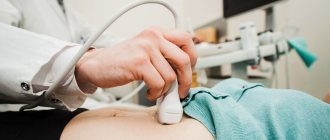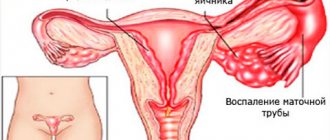- home
- Gynecology
- Adhesions in the pelvis
Interview with Prof. Puchkov on Medical Channel 1 on the topic: “Adhesive disease and infertility”
Adhesions in the pelvis are adhesions of connective tissue that appear on the surface of the pelvic organs. As a result, their mobility is limited and function may be impaired. When these organs are displaced, the adhesions become tense, which leads to pain.
The formation of adhesions refers to a protective reaction of the body aimed at delimiting a pathological focus from healthy tissues that appears due to various reasons: trauma, inflammation, exposure to air, circulatory disorders, etc. With any damage, the body strives to grow a new one on the unprotected area of the mesothelium, and substances are released , synthesizing fibrin. As a result, nearby organs are “glued together” with fibrin fibers.
Most often this occurs during surgical interventions, for example, after myomectomy, and adhesions in the pelvis after cesarean section are not uncommon. They also appear in urgent conditions associated with bleeding (for example, during ectopic pregnancy, ovarian apoplexy, abscesses, etc.), and adhesions in the pelvis in women are formed due to various diseases, for example, endometriosis, salpingitis, oophoritis, fibroids. The likelihood of the formation of adhesions depends on a number of factors: the properties of connective tissue determined genetically, weakened immunity and the individual predisposition of tissues to adhesions.
Symptoms of adhesions in the pelvis
At the initial stage, there are no complaints, adhesions are detected by chance. Over time, pain appears - with adhesions in the pelvis, they can be constant or occur during physical activity, sexual intercourse, and even when changing position. Nausea and vomiting may occur. In severe cases, intestinal obstruction develops due to compression of the intestinal lumen and circulatory disorders.
One of the serious consequences of adhesive disease is infertility. There are three stages of the process:
- I - the appearance of single adhesions near the ovary, tube, uterus is typical; nothing prevents the advancement of the egg;
- II - the ovary and tube are connected by dense adhesions, but half of the surface of the ovary is free; adhesions prevent the fimbriae from capturing the egg;
- III - the ovary is almost entirely covered with dense adhesions, the fallopian tubes are deformed and impassable, the lumen is blocked.
If pregnancy does occur, there is a risk of ectopic development due to an obstruction to the movement of the egg. At later stages, blood flow in the uterus may be disrupted, leading to miscarriage.
general information
All human internal organs easily move relative to each other thanks to the slippery membrane covering them. The mobility of an organ is an important criterion for its good condition and ability to perform its functions. Conversely, any violation of mobility, fixation, attachment to another structure means pathology, which inevitably leads first to malfunctions in the functioning of the organ (functional disorders), and over time to changes in its tissues (structural disorders).
error
The formation of adhesions on the ovaries, tubes (uterine appendages) is a connection (soldering) of the internal organs of the small pelvis that is not provided for by nature, disrupting their normal mobility.
Causes
The most common causes of the formation of adhesions of organs in the pelvis in women are as follows:
- abdominal surgeries,
- surgical abortions,
- long-term “hidden” infections,
- untreated or insufficiently treated inflammation of the uterine appendages,
- appendectomy,
- some venous diseases (gonorrhea, chlamydia),
- consequences of ovarian apoplexy,
- internal endometriosis.
The number of adhesions after delivery by cesarean section is two to three times greater than after laparoscopic operations on the pelvic organs. They can attach not only to the uterus, but also to the ovaries, rectum, and bladder, which leads to the appearance of certain symptoms. More than 50% of cases of abdominal pain and ovario-menstrual cycle disorders in girls are a consequence of the formation of adhesions in the pelvis.
How adhesions form in the pelvic organs
Let's consider the mechanism of formation of adhesions in women - regardless of the cause, it is approximately the same.
The space between the organs in our abdomen is filled with abdominal fluid. It is secreted by the peritoneum - a thin layer lining the abdominal cavity from the inside. With inflammation of internal organs, especially with genital infections, after surgery, the peritoneum becomes irritated, the secretion of fluid increases sharply, while the latter becomes more viscous and sticky (this is how nature helped our ancestors to localize, “seal up” deep damage from the inside).
In addition, when getting to the diseased organ during surgery, the surgeon cuts the multilayer films that ensure the free sliding of the organs. After the operation to remove an ovarian cyst, apoplexy, or appendicitis, sutures remain that tie this entire complex structure into knots, and the sticky liquid continues to be intensely released into the abdominal cavity for some time and begins to “glue” neighboring organs and tissues together.
As a result of the formation of the first point adhesions near the ovary or uterus, the axes of movement of these adherent organs change: they begin to move around the point of connection. Since movement near the commissure is limited, its area increases, increasingly reducing the mobility of the organ. Over time, a dense scar forms at the junction, which “tightly” holds the organs and tissues together.
ICD-10 code N73.6 Pelvic peritoneal adhesions in women.
What do adhesions look like in the pelvis (photo)
Photo 1. Adhesions around the ovary (stage of removal surgery).
Photo 2. Adhesions in the pelvis behind the uterus (chronic adnexitis)
Photo 3. Adhesion and adhesive process in the area of the appendages and uterus.
Due to the restriction of natural mobility, inadequate position and trajectory of movement of the organ, the work of the communications going to it is disrupted, which are stretched, pinched, twisted, etc. In this case, normal blood circulation and lymph flow may be disrupted, and spasms of the supporting ligaments and muscles may occur. To avoid consequences, after gynecological manipulations and operations in the pelvic area, it is necessary to undergo preventive treatment (read more about methods of treating adhesions in gynecology below).
Why is the adhesive process dangerous?
It would seem, what danger is fraught with removing the appendix? However, in this case, intestinal loops, primarily the cecum, are often involved in adhesive processes in the pelvis. Typical consequences are constipation, dysbacteriosis, biliary dyskinesia, etc. Girls often develop adhesions in the appendages, which can subsequently lead to painful periods, infertility, and ectopic pregnancy.
Recently, laparoscopy through a small hole has become popular in gynecology. With it, for a better view, the abdominal cavity is filled with gas. But if before the intervention the organs were perfectly ground in and easily slid relative to each other, then after surgery on the appendages or uterus, when the gas pressure subsides, their relative position differs from the original one. As a result, their mobility also decreases. In addition, during laparoscopy, the peritoneum is still noticeably irritated and secretes a sticky fluid, which leads, as during abdominal surgery, to the formation of adhesions in the pelvic organs, only on a smaller scale.
The most common complications of untreated adhesions on the ovaries in women are:
• infertility, • pain in the lower abdomen and during sexual intercourse, • varicose veins of the uterus and appendages; • backward bending of the uterus, • obstruction of the fallopian tubes, • ectopic pregnancy, • various menstrual cycle disorders.
Doctors often have to deal with the consequences of an episiotomy (an incision in the vagina during childbirth). A small incision to facilitate the passage of the fetus is a common occurrence in obstetric practice. However, over time, scarring of the vaginal tissue can lead to disruption of the position of the internal genital organs, dilated veins and varicose veins, and prolapse of the bladder and uterus. What can we say about possible adhesions in the pelvis after a cesarean section.
Symptoms of adhesions in the pelvis
So, in women, the adhesive process from the ovaries can spread in different directions, ultimately forming long chains of rigidly connected organs, tissues, and ligaments. Further damage occurs according to the principle “where it is thin, it breaks,” that is, the disease affects the most weakened organ located anywhere in such a chain (ovary, fallopian tube, ligaments).
The range of symptoms of adhesions in the appendage area is very wide. For example, restriction of lymph flow in the reproductive organs leads to a decrease in local immune defense, provoking inflammatory diseases. In turn, the obstructed inflow and outflow of blood causes symptoms such as congestion in the pelvis, varicose veins of the uterus and periuterine space, menstrual cycle and ovulation disorders, pain during intimacy.
Symptoms of pelvic adhesions are especially dangerous in girls and adolescents (after removal of appendicitis, surgery, chronic inflammation of the appendages, etc.). The organs and bones in this case have not yet formed. And the occurrence of adhesions in children at an early age affects the entire growing organism - in its development it begins to adapt to the axis or point of fixation. As a result, the diaphragm and other organs do not move as they should (one-sidedly), and the skeleton does not develop as expected—the child sits and moves askew.
If an adhesive process occurs in the female organs during adolescence, there is a risk of disruption of ovarian function, the menstrual cycle, and the appearance of pain in the lower abdomen. In this regard, not only treatment, but prevention of these complications is important, so be sure to consult a good pediatric or adolescent gynecologist.
What pain occurs with adhesions in the pelvis?
Most people suffering from this problem have approximately the same ovarian pain. Women who have adhesions on the ovaries leave approximately the same reviews of their sensations. What common signs do all such patients have:
- Causal connection with adnexitis, cystitis, surgical abortion, appendicitis, curettage after miscarriage;
- There has been a history of gynecological surgery or complicated appendicitis in the past;
- Prolonged ignoring of the symptoms of inflammation of the appendages and their careful treatment;
- The ovaries hurt, the adhesions of which were caused by the surgery, almost constantly, with a tendency for the pain to increase with exercise;
- During sexual intercourse, there is a pulling sensation, dull pain in the vagina, closer to the top, which intensifies with aggressive and overly active movement, in a knee-elbow position and with deep penetration of the penis;
- Pain in the iliac regions on the left or right, which occurs regularly and intensifies during sudden, intense physical activity, as well as before and during menstruation.
conclusions
From the above it follows that medical care is needed not only for established pathology. Any woman who has undergone an abortion, abdominal surgery, cauterization of the cervix, inflammation of the appendages, hysteroscopy and laparoscopy, it is advisable to consult a gynecologist to prevent the development of the disease. To prevent the development of adhesions after appendicitis in children (girls, adolescents), it is necessary to visit a specialist in pediatric gynecology (accepted in our center).
In addition, it is advisable to visit a gynecologist before pregnancy, as well as after childbirth. This will help avoid many serious problems in the future. Our gynecology doctors in Moscow treat adhesions without surgery using proven techniques, which in the vast majority of cases avoids possible complications.
Diagnostics
The disease can be suspected if there are relevant patient complaints and medical history. To confirm the diagnosis, a number of examinations are carried out, which include:
- Ultrasound - adhesions in the pelvis are detected in the form of heterogeneous echo signals;
- Hysterosalpingography and hysterosalpingoscopy - performed to assess tubal involvement;
- MRI of the pelvic organs;
- Diagnostic laparoscopy is effective for visualizing adhesions between organs.
To identify the causes of adhesions, laboratory tests may be prescribed: determination of flora, STIs, PCR diagnostics, etc.
Causes
The adhesive process in the pelvis can begin after diseases of the internal organs of the small pelvis, improper treatment and for other reasons. It can be:
- abortion or wearing an intrauterine device,
- surgical interventions using the laparoscopic method,
- pathological endometriosis of the peritoneum,
- infectious diseases of the female genital area,
- hemorrhages in the abdominal cavity (ectopic pregnancy, ovarian apoplexy),
- inflammation of the appendix (appendix) and appendectomy.
In all of these cases, adhesions of the pelvic organs can be prevented if you follow the doctor’s recommendations in the postoperative period or regularly engage in the prevention of the formation of adhesions.
Any advanced pelvic disease leads to the inevitable onset of adhesions in the pelvis.
Treatment of adhesions in the pelvis in women
Conservative therapy is recommended to prevent complications; if the disease appears as a result of an infection, antibacterial drugs may be prescribed; for endometriosis, hormone therapy; for pain relief, as well as for the inflammatory process, anti-inflammatory drugs may be recommended; fibrinolytics are prescribed for resorption.
The goal of surgical treatment is to cut the adhesions and free the organs. Indications for surgery are:
- severe pain syndrome;
- risk of developing intestinal obstruction;
- female infertility.
How are adhesions on the female genital organs and infertility related?
The most well-known consequence of the appearance of synechiae is partial or complete obstruction of the fallopian tubes. Most often, the presence of adhesions is detected when a woman consults a gynecologist with a complaint of prolonged inability to become pregnant.
The fallopian tubes are the place where, during ovulation, the egg prepares for fertilization.
After colliding with a sperm, the egg moves through the tube to exit into the uterus and attach there. If synechiae are present in the fallopian tube, the path of the egg becomes obstructed, and pregnancy ultimately does not occur. In addition, adhesions can change the shape of the fallopian tube, which also prevents the egg from attaching to the wall of the uterus. Sometimes, especially with chronic forms of tubal obstruction, adhesions can provoke an ectopic pregnancy.
Thus, adhesions are one of the main causes of infertility. Fortunately, modern medicine can effectively get rid of them, increasing the likelihood of a successful pregnancy.
Laparoscopy for adhesions in the pelvis
Video from the operating room. Laparoscopic cystadnexectomy for severe adhesions
The gold standard for the surgical treatment of adhesions is laparoscopy, during which all adhesions are sequentially intersected. At the same time, I select the choice of instruments taking into account the area of intervention; when dissecting adhesions between the peritoneal wall and the omentum or intestine, I use the Liga Sure device, which allows for bloodless manipulations while simultaneously sealing the vessels. Between intestinal loops, I always use a cold method for dissection, without electrosurgery, to avoid damage to the intestinal wall with subsequent perforation.
To prevent adhesions and fusion of organs, I use special anti-adhesion barriers, which dissolve without a trace after 7-10 days. These drugs are effective in the presence of exudate and blood, are safe, encapsulation is excluded, and do not require fastening with sutures.
The advantage of laparoscopy is the absence of extensive damage; there is no drying out of the operation area, since carbon dioxide is introduced instead of air (in open surgery), which dries out the peritoneum. When washing, solutions are used, which, unlike napkins, does not injure the mesothelium. Also among the advantages of laparoscopy are the absence of blood loss and high precision of manipulation due to the possibility of visualization. To prevent adhesions and fusion of organs, I use special membranes that dissolve without a trace after 7-10 days.
Our patients are usually discharged on days 2-4; three days after discharge, we conduct a follow-up examination and make recommendations for further treatment. After laparoscopy, a woman can return to her usual lifestyle within two weeks.
I have been performing such interventions since 1993, and have performed more than 900 operations to remove adhesions. I also use modern technologies to prevent the appearance of adhesions during any surgical procedure. Thanks to the modern approach, the likelihood of developing adhesions during surgery in our clinic has been reduced tenfold.
Methods for eliminating synechiae
How to cure adhesions in the fallopian tubes and how to get pregnant? Various methods can be used aimed at restoring the normal functional and anatomical state of these organs. In unadvanced cases, it is possible to cope with the problem conservatively; in advanced cases, surgical intervention is performed. However, with the fourth degree of adhesive disease, its effectiveness does not exceed 15-20%.
The solution to this situation is IVF. In this case, the fallopian tubes are not involved in the process, and a 3-5-day embryo is immediately implanted into the site of its future implantation (uterine cavity). IVF for tubal infertility is the most successful, and the percentage of successful attempts is quite high.
Medication
Drug treatment can be effective during exacerbation of the chronic process, when fluid is detected in the fallopian tubes. Timely prescribed antimicrobial therapy helps stop inflammation, prevent excessive adhesions and restore patency of the fallopian tubes. For already formed synechiae, conservative treatment methods are ineffective.
Physiotherapy
Physiotherapy is used at the next stage of treatment of the inflammatory process, after it subsides. The method is also indicated in the early postoperative period to prevent the formation of adhesions. The most optimal method and dosage regimen is selected by a qualified physiotherapist who specializes in the gynecological field.
Laparoscopy
Is it possible to remove adhesions in the fallopian tubes? Yes, with the help of their dissection during laparoscopy. However, the risk of relapse is quite high. Therefore, such operations are performed on a limited number of women.
If IVF is planned, then laparoscopy can be a preparatory step. In this situation, surgery involves complete removal of the fallopian tubes. A tubectomy is performed when the tube is completely blocked and there is an increased risk of ectopic pregnancy.
Popular questions
Good afternoon!
5 years ago there was an operation: the tubes and 1 ovary were removed. Now I am 43 years old and menopause has begun: all the symptoms and menstruation have stopped. Please tell me, is there any treatment option other than hormones? It's a very difficult situation right now. What natural remedies can be used? Thank you Hello! You can use products containing phytoestrogens, antioxidants, and vitamin complexes. This will help alleviate the condition. Such drugs in the line of products include Gynocomfort climafemin. The product is used 1 t once a day for 3 months.
Is it possible to restore tubes if they are cut and tied. If yes, how to do it?
Hello! After sterilization, it is virtually impossible to restore the patency of the fallopian tubes and successful functioning for the implementation of reproductive plans. I recommend contacting a fertility specialist for a possible decision in favor of IVF.
13 years ago I had an ectopic pregnancy, one tube was removed, the second was tied. Is it possible to restore the tube, if not, is IVF done?
Hello! In this case, you should consult a reproductologist to prepare for an IVF program with the indication of tubal factor infertility.
Good afternoon, I had an ectopic pregnancy. On 06/30/19 they had an operation and removed the right tube, but there was no period, although it was supposed to come on 07/22/25. I checked, the test showed 2 stripes, tell me, am I pregnant again?
Hello!
After the operation, there should have been bloody discharge from the genital tract immediately, since the pregnancy was removed and the mucous membrane was rejected from the uterine cavity. Therefore, the cycle will be restored to a new rhythm in 28-32 days. You should have been warned about sexual rest until your cycle returns and the need for contraception for 6 to 12 months. If you did not follow this, then you may be pregnant. The test gives a false positive result up to 1 month after a terminated pregnancy. It is more effective to get tested for hCG levels at intervals of 2 days; a drop should be noted. If, on the contrary, there is an increase, then you should immediately consult a doctor. For an accurate diagnosis, contact a specialist
Surgical treatment of adhesive disease
Treatment is a very difficult task - you can never be sure that a laparotomy performed for adhesive disease will be the last for the patient and will eliminate the process that caused the adhesive process. Therefore, it is always worth considering the feasibility of a particular operation and drawing up a clear plan based on a clinical examination. Only in emergency cases should this scheme be abandoned. The question of the soldering of small intestinal loops to the scar remains open. Therefore, during laparotomy, the old scar should not be excised - the incision is made 2-3 cm away from the scar.
When separating intestinal adhesions, it is advisable to use hydraulic preparation with novocaine. Deserosed areas of the intestinal walls must be carefully sutured. The soldered sections of the gland should be crossed between the applied ligatures. In cases where the intestinal loops form very adherent conglomerates, and it is not possible to separate them, it is necessary to apply a bypass anastomosis between the adductor and efferent intestines (as if to shunt), since the separation of this conglomerate will take a lot of time, and secondly, it will cause additional trauma to the peritoneum . Before deciding on planned surgical intervention, patients require a high-quality X-ray examination. During surgery, releasing intestinal loops from adhesions is a rather difficult task, which, according to Noble, takes about 90% of the operation time. In 1937, Noble proposed an operation, which was called Noble enteroplication of the intestine.
The essence of the operation is that after separation of the adhesions, the intestinal loops were laid horizontally or vertically and sutured together in the area of the mesenteric edge with a continuous thread. Thus, the intestinal loops were fixed in a certain position, and later they grew together. Recurrences of intestinal obstruction were observed after surgery - 12-15%, so this operation was treated with caution. In addition, stitching the intestinal loops takes a lot of time, then the loops begin to peristalt worse.
In 1960, this operating principle was modified by Chalds and Phillips, who proposed to perform enteroplication not by suturing intestinal loops, but by suturing the mesentery of the small intestine with a long needle. Surgery using this method provides better peristalsis and an easier postoperative period. In addition, less time is spent on this operation.
In 1956, White and in 1960, Deder proposed fixation of intestinal loops with an elastic tube inserted into the intestinal lumen by enterostomy. Dederer proposed performing a microgastrostomy, through which a long tube with many holes was inserted throughout the entire length of the small intestine. This method is not bad at all due to the fact that the tube was a frame for intestinal loops and the loops were fixed and fused in a functionally advantageous position. But opening the stomach cavity (Dederer) or intestine (White) was unfavorable with regard to infection of the abdominal cavity. However, during operations for intestinal obstruction, the tube is passed transnasally, bringing it almost to the ileocecal angle.
The tube is fixed to the wing of the nose; later, during the period of intestinal paresis, the contents of the intestine are drained through this tube; nutrients can be introduced into this tube. But basically it is removed a few days after surgery, after reliable restoration of peristalsis, since long-term removal of intestinal contents can cause electrolyte imbalances.
Symptoms
Symptoms in the presence of adhesions in a woman are very different, however, several common signs can be identified:
- Chronic pelvic pain syndrome is a constant, sometimes almost imperceptible, dull pain in the area of adhesion formation. It occurs due to tension and deformation of organs. In some cases, it can radiate to surrounding organs, the lower back and legs. The pain may intensify during sexual intercourse, physical exercise and prolonged exercise, hypothermia, and when the bladder is full.
- Impaired organ function - reduction or disappearance of menstruation, lack of ovulation, inability to become pregnant.
- In cases of formation of adhesions with intestinal loops - constipation, feeling of bloating, intestinal obstruction.
It is also worth noting that if a woman has adhesions, it is quite possible for her to experience increased pain during menstruation and ovulation. But it is worth considering that in half of the cases, adhesions do not cause any symptoms and are detected only during an ultrasound of the pelvic organs or a visual examination.
Symptoms of tubal obstruction
Depending on the number of adhesions and the fallopian tubes affected by them, the clinical picture also differs. Obstetricians-gynecologists note the individual manifestation of symptoms of uterine adhesions and therefore recommend examination at least twice a year.
In some cases, the appearance of adhesions is asymptomatic, and the only thing that can indicate them is the inability to get pregnant. Do adhesions hurt? Sometimes women feel a nagging or aching pain in the lower abdomen, especially after physical activity. In addition, in some cases, the amount of vaginal discharge increases, sometimes with pus. A strong manifestation of pain or a sharp increase in body temperature indicates an acute form of the inflammatory process, therefore, in case of sharp pain in the iliac regions (as during contractions) and other similar ailments, try to promptly consult a doctor.
Contraindications for surgery
List of contraindications for laparoscopic dissection of adhesions:
- acute infections and diseases;
- exacerbation of chronic pathology;
- severe damage to the heart, blood vessels and respiratory tract (due to problems with anesthesia);
- severe damage to the kidneys, liver, digestion until the condition stabilizes;
- serious and uncorrectable metabolic problems;
- blood clotting disorders;
- pregnancy period.
After the examination, the doctor can determine other individual contraindications, for example, allergies or intolerance to anesthesia or medications, and then the issue of intervention is decided individually.
Postoperative period
The recovery period after the intervention is not long. If there are no complications or complaints, the patient goes home the next day; pain and discomfort in the abdominal area disappear within 3-4 days after the intervention. Full recovery takes up to 4-6 weeks. During this time, a diet is needed to prevent gas formation and intestinal overload, limiting exercise, a temporary ban on intimate life, visiting a sauna, bathhouse.
After surgery, the sutures are treated with antiseptics for 6-7 days, then they are completely tightened. As they recover, they become almost invisible.
Preparation
The operation is carried out as planned; before it, the woman must undergo a full examination in order to exclude contraindications and any health problems that require additional treatment. It is important to be examined by a gynecologist and undergo all the required tests, as well as a physician’s opinion on the possibility of surgery. You need to do:
- general blood test in combination with coagulation studies (blood for clotting), hormone levels, determination of biochemical parameters;
- urine tests to exclude urological infections;
- Ultrasound of the abdominal cavity and pelvis to determine the anatomical features of the body;
- research to exclude hepatitis, HIV and sexually transmitted infections.
2-3 days before surgery, a light diet, laxatives, and bowel cleansing are necessary. After 6 pm before the operation, it is forbidden to eat, and in the morning before the operation you should also not drink.
Is it possible to completely get rid of adhesions?
Most often, obstetricians-gynecologists give a positive answer to this question. Modern methods of treating synechiae make it possible to effectively and accurately remove adhesions, preventing their further occurrence. According to statistics, after removal of adhesions, pregnancy occurs in almost 85% of cases, which indicates a favorable prognosis for treatment of adhesions.
We will talk in more detail about ways to deal with adhesive threads later.









